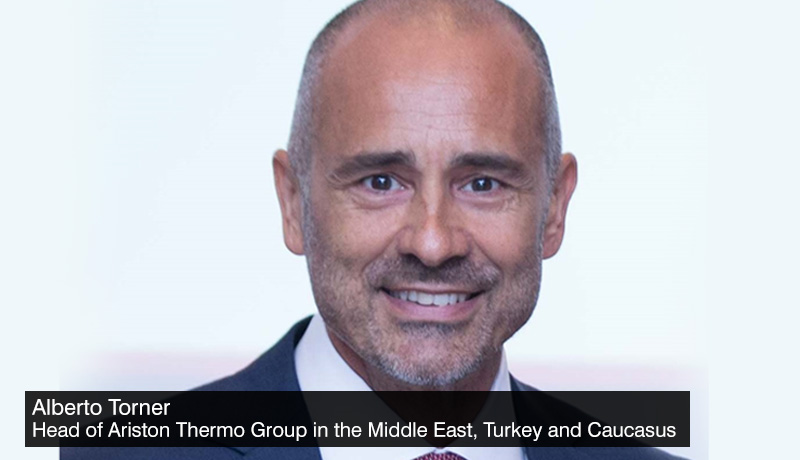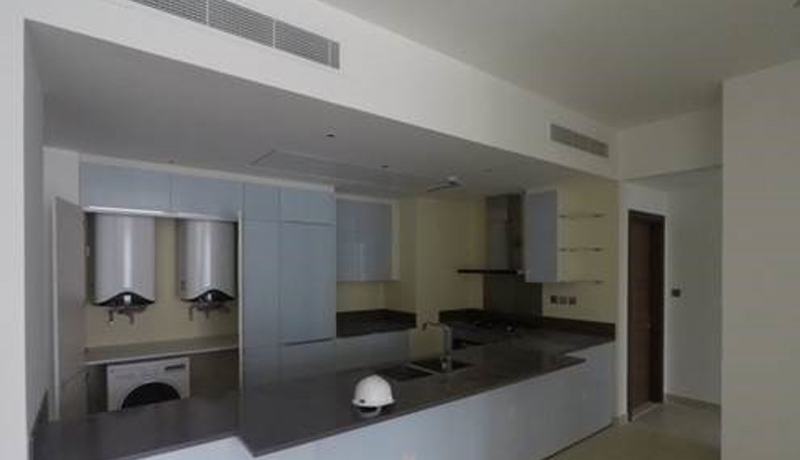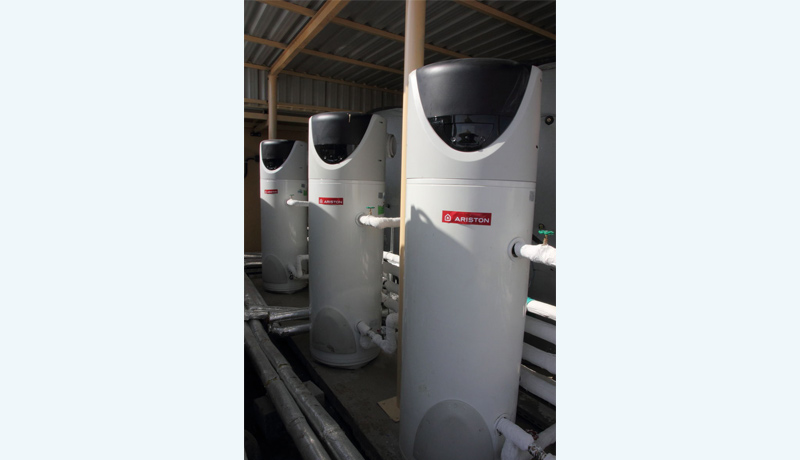
Interview with Alberto Torner, Head of Ariston Thermo Group in the Middle East, Turkey and Caucasus.
Alberto: For many years, Ariston has chosen a green path and for this reason, it has been investing in the most advanced technology in its sector.
Ariston’s Heat pump water heater range uses a thermodynamic cycle to heat the water inside the storage tank through the air sucked by the thermal group inverting the heat natural flow.
A refrigerant fluid (R134A), through status changes, compression and expansion cycles, withdraws the heat in the air at low temperature and gives it to domestic water at a higher temperature. This is the reverse mechanism to the one used in refrigerators.
Electricity is consumed only to let the fan (that captures the air) and the compressor (allows the refrigerant fluid to circulate in the system) work.
In simple words, Heat pumps are the best example of technology in complete harmony with the environment that works by absorbing the free and organic heat directly from the air.
Ariston offers both residential and commercial heat pumps for the market. Our NUOS range is available both in monoblock and split versions (with an external unit) and can be installed both on the wall and on the floor, with a capacity from 80 upto 300 litres. In new buildings, NUOS range can be used as an alternative to the solar thermal as a renewable energy source.

Alberto: Climate Change and reports have seized the attention of world leaders. The UN panel on climate change sounded a dire warning as recently as Monday, August 9, 2021, that the world is dangerously close to runaway warming – and that humans are ‘unequivocally’ to blame.
A report of the International Energy Agency says that, if we consider the total number of possible areas of intervention for curbing CO2 emissions by 2040, 37% derives from the energy efficiency of products used by end-users. According to another report by ReThink Energy NJ, the key to reducing GHG emissions by 80% by 2050 is to remove emissions created by the electric power sector. This will be achieved by using cleaner energy to run transportation, heating, cooling, and other systems. Energy-efficient products have a big part to play in reducing the amount of electricity consumed by residential and commercial entities. Heat Pumps are a prime example of technology that will address this global issue.
Governments in the Middle East, especially GCC and particularly the UAE endorse World Leaders’ sentiments on Climate Change.
The UAE has historically been a pioneer in the region in developing renewable energy and other environment-friendly technologies. Domestically, the UAE’s clean power capacity, including solar and nuclear, is on track to reach 14 GW by 2030, from just above 100 MW in 2015 and 2.4 GW in 2020. The UAE has established the region’s first commercial-scale CCUS network, Al Reyadah, advancing the deployment of technology critical for carbon reduction and climate change mitigation.
The UAE was the first Gulf country to sign and ratify the Paris Accords and its recently announced Nationally Determined Contribution (NDC) represents the region’s first economy-wide target to reduce emissions.
Approved by the UAE Cabinet in December 2020, the UAE’s second NDC includes an enhanced greenhouse gas emissions reduction of 23.5 percent compared to business as usual for the year 2030. The enhanced target is expected to translate into an absolute emissions reduction of about 70 million tons.
In 2019, the commercial category, based on end user, held the largest revenue share in the U.A.E. heating equipment market due to the increasing number of hotels & restaurants, commercial offices & buildings, healthcare facilities, and other commercial spaces in the nation.
The UAE government is moving towards accepting heat pumps as a renewable energy source alongside solar systems, but the UAE still has a long way to go. Consultants and contractors should make more significant efforts to comply with local and international government objectives in reducing CO2 and achieving greater renewable efficiencies.
With the upcoming Dubai Expo 2020 and government efforts to promote tourism, the emirate would witness large-scale construction activities in the coming years.
Alberto: Working of Thermodynamic Cycle
A-B External air is aspirated inside the heat pump thanks to a fan; when passing through fins of the evaporator, the air gives it heat and loses 10degree Celcius approx. Finally, it is expelled.
1-2 The refrigerant fluid goes through the evaporator and absorbs the heat given by the air. During this process, it changes the physical status and evaporates keeping the temperature and pressure almost constant. (0 degree:5 Bar)
2-3 – The refrigerant fluid crosses the compressor and experiences a pressure rising which involves an increase in temperature. At the end of the process, the fluid is overheated vapor and its temperature and pressure are 70 degrees C and 20 bar respectively.
3-4 When the condenser, the refrigerant fluid gives its heat to the water which warms up. By doing this, the refrigerant condensate at constant pressure (20 bar and then experiences a significant reduction of temperature (70->40 degrees Celcius)
4-1 The refrigerant fluid passes through the throttling valve, suddenly loses both pressure and temperature and partially evaporate thus returning to the initial conditions of temperature and pressure (40->0degreeC,5 bar)

Alberto: We have implemented several projects in UAE, GCC and the wider MENA region.
Twelve recently completed projects in the UAE leverage heat pump technology to provide hot water requirements. Four of the projects are residential whereas eight are commercial. Of the commercial installations, four are hotels in Dubai and the remainder comprise a Staff Dining Hall, the Fire & Ambulance station at Expo 2020, a GEMS school and the Fujairah Business Centre.
Many hotels leverage solar power in conjunction with heat pumps to heat water. The Hilton Hotel in RAK and the Marriott Courtyard in Barsha are examples of harnessing solar power with heat pump technology. These systems represent a perfect integration of different renewable solutions: sun and air.

